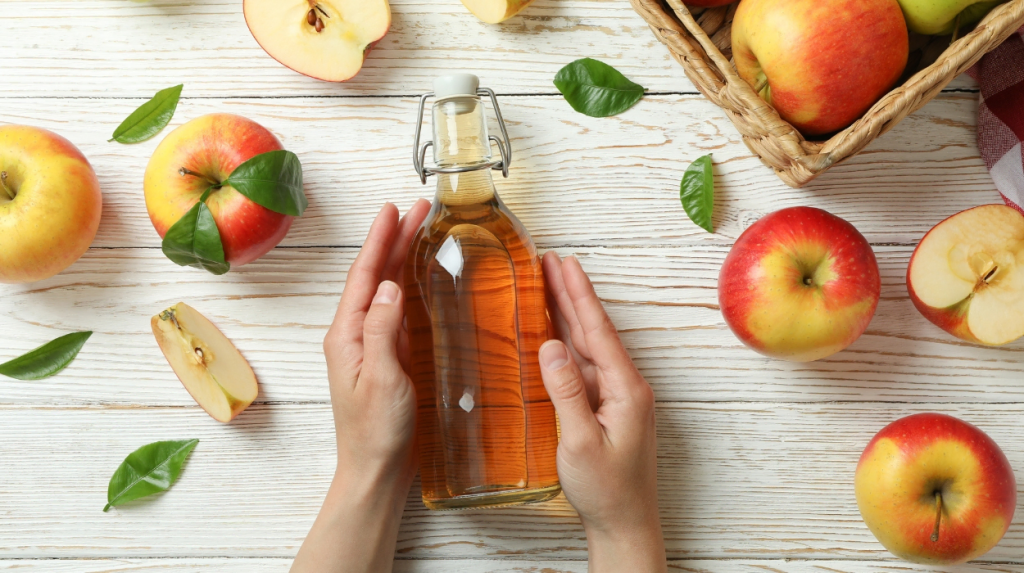You might have heard about apple cider vinegar baths and how they bring on a plethora of health benefits. But what do they actually consist of, are they as healthy as they seem, and how often can you take them?
Apple cider vinegar (ACV) has been a well-known remedy for thousands of years, and it was used for a myriad of medicinal treatments such as fighting coughs and infections, showcasing its powerful antimicrobial and antifungal properties. Today, ACV is also being used to treat skin issues, acid reflux, and other digestive disorders and help with weight loss. Taking it on an empty stomach first thing in the morning is said to coat your gut lining and help lower inflammation. Now the trend of getting an ACV bath has taken over the world, with many people swearing about its wonderful benefits.
Apple cider vinegar is twice-fermented apple juice that transforms alcohol into acetic acid. When you’re buying it in the grocery store, you can get pasteurized or raw apple cider vinegar. Raw ACV usually has more natural bacteria and yeast, commonly known as “the mother,” which can usually be seen as the sediment at the bottom of the bottle.
Apple cider vinegar contains naturally occurring probiotics[1] and antioxidants which can help fight free radicals and protect you from oxidative cell damage. It also helps inhibit bacteria growth,[2] may help lower your blood sugar levels,[3] and heals skin infections and issues, making it an amazing remedy[4] for sensitive skin.
Apple Cider Vinegar Bath Benefits
- Fights Bacteria, Fungi, And Infections
- Protects Against Body Odor
- Helps Treat And Heal Wounds
- May Help Treat Eczema
- Helps Treat Athlete’s Foot And Strengthens Skin
- Helps Treat Urinary Tract Infections
- Could Help Treat Yeast Infection And Bacterial Vaginosis
- Act As A Powerful Detox Remedy
- Helps Fight Dandruff
9 Apple Cider Vinegar Bath Benefits
Fights Bacteria, Fungi, And Infections
Apple cider vinegar has powerful antimicrobial and antifungal properties that help protect the body from infections[2] as well as inhibit bacterial growth. Studies also show its potent antifungal characteristics that help against denture stomatitis, food-borne pathogens, and a variety of other microbial infections.
Furthermore, ACV helps protect your entire body against microbial protein expression, fungal infection and even damaged skin which causes bacteria build-up and inflammation. Some of the most prominent bacteria that ACV affects include Staphylococcus aureus Escherichia coli, and Candida albicans.
Protects Against Body Odor

Because of its antimicrobial properties, apple cider vinegar could potentially help kill several types of bacteria found on the skin that, when mixed with sweat, cause unpleasant body odor. Taking an apple cider vinegar bath could help naturally clear away some of these bacteria, at least temporarily. It also balances the skin’s pH, preventing inflammation and the potential development of new pathogens.
The same goes for foot odor and fungal infections. Soaking your feet in an apple cider vinegar bath could help fight off odor-causing fungi, helping you get rid of unpleasant foot odor and skin infections.
Helps Treat And Heal Wounds
Acetic acid’s healing tendencies seem to shine through in treating burn wounds. It works by killing bacteria found thriving in the damaged tissue, especially bacteria such as Pseudomonas aeruginosa,[5] which is often found in skin and burn wounds. It also helps strengthen the skin’s protective layer, improve skin barrier integrity, and help it retain moisture.
May Help Treat Eczema
When you’re suffering from a dysfunctional skin barrier that becomes less acidic than it’s supposed to be, you’re constantly losing moisture, and your skin begins to dry out rapidly. This can cause inflammation and irritation, causing many potential skin problems down the line.
Atopic dermatitis can potentially be helped[6] with an apple cider vinegar bath. The applied mild acid could help restore the skin barrier, keeping it healthy and locking in the much-needed moisture. Some peer-reviewed studies[4] done on animals even show that a topical application of apple cider vinegar helped inhibit the development of lesions, promoting healthy skin management and preventing dry skin patches.
Helps Treat Athlete’s Foot And Strengthens Skin
A simple apple cider vinegar foot soak may be the perfect solution for treating[7] athlete’s foot and it can significantly reduce[8] acne vulgaris and even skin lesions. Many people use apple cider vinegar in their face wash, using its potent antimicrobial, anti-inflammatory, and antifungal properties.
There are now plenty of skincare products on the market already containing apple cider vinegar in the optimal dose, so you never have to worry about excess vinegar or disrupting your skin’s pH levels. Still, it’s always important to consult with a dermatologist before applying powerful acids to your skin, as you never know how your skin might react.
Helps Treat Urinary Tract Infections
An overgrowth of E. coli bacteria somewhere along the urinary tract causes unpleasant urinary tract infections or UTIs that can potentially become really complicated and serious.[9] Researchers believe that apple cider vinegar can help kill some of these bacteria, preventing further spread and growth, thus stopping the infection from going too far.
Even though taking ACV baths is fine, most experts do believe that drinking apple cider vinegar can be more beneficial in treating this condition.
Could Help Treat Yeast Infection And Bacterial Vaginosis
These female conditions are caused by an overgrowth of bacteria and candida, the most common fungus in the vaginal flora. ACV has proven[2] to help kill these bacteria and fungi, inhibiting their further growth and infection. Since almost all women struggle with vaginal infections, knowing they have a powerful remedy in their kitchen is a very helpful tool, especially before that time of the month.
Act As A Powerful Detox Remedy

As detoxification (detox) wellness tips and tricks seem to be the newest trend, those in favor of taking apple cider vinegar soaks love combining it with other natural detoxing ingredients such as ginger, cinnamon, and turmeric. Together, these incredible compounds help draw out harmful toxins that damage the skin on a cellular level, cause severe inflammation, and promote diseases like arthritis and gout.
They also help restore skin health and a healthy pH balance by strengthening the skin barrier and enhancing your metabolism, supporting the digestive system, fighting muscle tension, and boosting the immune system.
Helps Fight Dandruff
Even though the exact cause of dandruff is yet to be discovered, one of the most common culprits includes a yeast-like fungus called Malassezia. This dandruff-causing fungus is persistent, and it’s known to resist even the strongest over-the-counter remedies and hair products. Since ACV has strong antifungal activity, it can help reduce and kill yeast overgrowth, inhibiting its spread and reducing yeast-like symptoms like itchy scalp and flaking.
Is Apple Cider Vinegar Bath Good For Your Body?
Adding apple cider vinegar to your bath water is supposed to detox your body and help you flush out toxins more efficiently. It also works wonders for your skin health, helping you fight bacterial infections and fungi, soothe irritation, keep the moisture locked in, and restore the natural pH balance of your skin.
In addition, the way you use it can be completely controlled as you can dilute it as much as you want. Depending on your preference, you can then have apple cider vinegar baths as often or as rarely as you’d like. It is, however, recommended not to exceed the two or three times per week instruction, but it will always depend on the individual, as everyone’s skin is different and reacts differently to acids.
How To Make An Apple Cider Vinegar Bath?
Generally, it’s best not to exceed the recommended 2-3 times per week recipe, but depending on how diluted your apple cider vinegar bath treatment is and the sensitivity of your skin, that number can be lower or greater. Taking too many baths can be counterproductive as it can irritate your skin, strip it of natural oils, and expose it to inflammatory agents.
Here are the most common tips:
- The formula for your ACV bath is 1-2 cups of apple cider vinegar against a full bath.
- Proper dilution is key. Direct application of apple cider vinegar to the skin is very likely to irritate it.
- The temperature of the water is also very important. You don’t want cool water or really hot. Try to aim for lukewarm water.
- Rinse your body before and after your ACV bath in order to cleanse dirt, oils, and debris, helping reduce potential irritation and redness.
- Before you dip your whole body into the acidic water, try it out on a smaller piece of skin first. If no irritation occurs, continue with the full bath.
- Don’t stay for over 20-30 min.
- Avoid rubbing your towel after your bath in order to prevent irritation. Instead, simply dab and pat until dry.
- Start with once per week and increase to two or three times when you see your skin adapt to it.
Final Thought
Apple cider vinegar baths are a new trend that might be incredibly beneficial and have many medicinal purposes. Its powerful anti-inflammatory, antimicrobial, and anti-fungal properties make it an affordable and easy-to-use tool for preventing infections and diseases, helping you balance out your skin’s pH, retaining moisture, and preventing dry skin, in addition to promoting overall healthy skin. The only trick is to not overdo it and take it one step at a time.
+ 9 Sources
- Cousin, F.J., Rozenn Le Guellec, Schlusselhuber, M., Dalmasso, M., Laplace, J.-M. and Cretenet, M. (2017). Microorganisms in Fermented Apple Beverages: Current Knowledge and Future Directions. Microorganisms, [online] 5(3), pp.39–39. doi:https://doi.org/10.3390/microorganisms5030039.
- Darshna Yagnik, Serafin, V. and Shah, A.J. (2018). Antimicrobial activity of apple cider vinegar against Escherichia coli, Staphylococcus aureus and Candida albicans; downregulating cytokine and microbial protein expression. Scientific Reports, [online] 8(1). doi:https://doi.org/10.1038/s41598-017-18618-x.
- Brighenti (2019). Effect of neutralized and native vinegar on blood glucose and acetate responses to a mixed meal in healthy subjects. European journal of clinical nutrition, [online] 49(4). Available at: https://pubmed.ncbi.nlm.nih.gov/7796781/.
- Noo Ri Lee, Hae Jin Lee, Na Young Yoon, Kim, D., Jung, M. and Eung Ho Choi (2016). Application of Topical Acids Improves Atopic Dermatitis in Murine Model by Enhancement of Skin Barrier Functions Regardless of the Origin of Acids. Annals of Dermatology, [online] 28(6), pp.690–690. doi:https://doi.org/10.5021/ad.2016.28.6.690.
- Sloss, J.M., Cumberland, N. and Milner, S.M. (1993). Acetic acid used for the elimination of Pseudomonas aeruginosa from burn and soft tissue wounds. Journal of the Royal Army Medical Corps, [online] 139(2), pp.49–51. doi:https://doi.org/10.1136/jramc-139-02-04.
- Elias, P.M. and Wakefield, J.S. (2014). Mechanisms of abnormal lamellar body secretion and the dysfunctional skin barrier in patients with atopic dermatitis. Journal of Allergy and Clinical Immunology, [online] 134(4), pp.781-791.e1. doi:https://doi.org/10.1016/j.jaci.2014.05.048.
- Nih.gov. (2018). What helps to get rid of athlete’s foot? [online] Available at: https://www.ncbi.nlm.nih.gov/books/NBK279548/.
- Garg (2023). Long term topical application of lactic acid/lactate lotion as a preventive treatment for acne vulgaris. Indian journal of dermatology, venereology and leprology, [online] 68(3). Available at: https://pubmed.ncbi.nlm.nih.gov/17656910/.
- Ayan Sabih and Leslie, S.W. (2023). Complicated Urinary Tract Infections. [online] Nih.gov. Available at: https://www.ncbi.nlm.nih.gov/books/NBK436013/.
